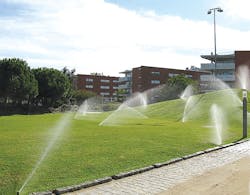Does last summer’s near-record heat have you sweating about the upcoming irrigation season? Maybe it’s time to add smart landscape sensors to your arsenal.
These devices interact with your existing irrigation system to put water where it counts and when it’s needed, rather than leaving all the work to a simple timer that waters your lawn daily regardless of weather conditions. By ensuring that you only irrigate when your grounds need it, a suite of sensors helps cut down on wasted water.
Make the Right Sensor Selection
There are three main categories of landscape sensors that can complement your existing irrigation system.
Rain sensors: The dominant rain sensor on the market is an expanding disc type, says Michael Dukes, a professor and irrigation specialist for the University of Florida’s agricultural and biological engineering department and director of the Center for Landscape Conservation and Ecology.
These simple sensors contain discs made of a hygroscopic material that expands when wet; when they reach a predetermined level of expansion, they trip a switch that interrupts the signal between your irrigation’s time clock and water valve, preventing the irrigation system from watering your site if sufficient rain has fallen.
Soil moisture sensors: These also interfere with the signal between the time clock and valve, but their decision is based on the actual moisture content in the surrounding soil rather than rainfall.
Evapotranspiration (ET) controllers: ET devices measure weather variables (such as rainfall, temperature, relative humidity, or other important markers) and compare that to how much water plants are using in a certain irrigation zone, Dukes explains. Soil moisture sensors and ET controllers are considered “smart” irrigation technology, meaning that they do more than just stop irrigating after a certain amount of rainfall.
The optimal choice for your site depends on multiple factors, and an ongoing debate on the merits of ET vs. soil moisture sensors continues, Dukes says. However, either control can get you started on the path to savings.
“There are a few extreme situations like rocky soils where it’s difficult to install soil moisture sensors because you can’t get good contact between the soil and the sensor, but both evapotranspiration and soil moisture sensors can work under most other conditions,” explains Dukes.
Smart Soil Strategies
You can distribute sensors in as many irrigation zones as you’d like, but a good rule of thumb to remember is that the sensor’s location must be representative of the entire zone it controls, Dukes explains. The size and placement of those zones can vary depending on watering requirements and other characteristics, such as soil conditions, slope, and exposure to sun, shade, and wind, according to the EPA.
“Group plants that have like irrigation needs together. You wouldn’t want an irrigation zone that combines turf grass with a drought-tolerant shrub – you’d have to overwater the shrub to meet the needs of the turf grass,” says Dukes. “Even if the plants are the same, you may have different soil conditions that would dictate a need for multiple sensors. One area may be well-drained and another may be more poorly drained; in that case, you need more irrigation on the well-drained one because it doesn’t hold water as tightly.”
Also evaluate your current setup before adding extra technology, recommends Mark Spears, a civil engineer for the U.S. Bureau of Reclamation who contributed to a guide on smart irrigation controls. A site full of landscape sensors can’t correct already dysfunctional irrigation equipment.
“The key thing is to properly correct any problems with the existing irrigation system. Make sure it’s installed properly,” explains Spears. “Once installed, these sensors typically don’t require maintenance.”
Maximize Savings
To truly wring every drop of efficiency out of your landscape practices, the EPA recommends installing a separate water meter to measure how much water you’re applying to the landscape – this will give you greater insight and could provide additional sources of savings.
Performance results naturally vary depending on climate, landscape, variations in weather, and other factors, but the EPA provided BUILDINGS with a handful of real-world examples to illustrate the spectrum of potential savings:
- Water-efficient sprinkler technologies can reduce water use by as much as 30% when compared to standard pop-up sprinklers.
- Properly installing a WaterSense-labeled, weather-based irrigation controller may reduce irrigation water use by 15%.
- A project in Florida demonstrated a savings of 13,567 gallons every time a rain sensor prevented an irrigation event on half an acre of landscape.
- Turf plot studies demonstrated that water savings from soil moisture sensors ranges anywhere from 4-88%.
Janelle Penny is senior editor of BUILDINGS.
About the Author
Janelle Penny
Editor-in-Chief at BUILDINGS
Janelle Penny has been with BUILDINGS since 2010. She is a two-time FOLIO: Eddie award winner who aims to deliver practical, actionable content for building owners and facilities professionals.

